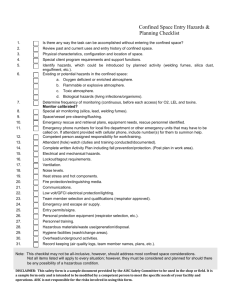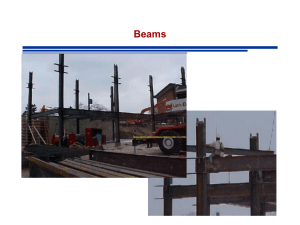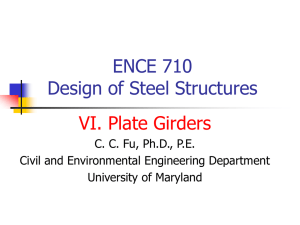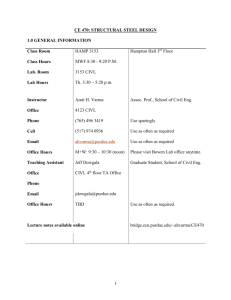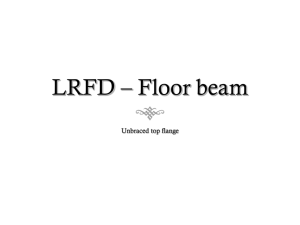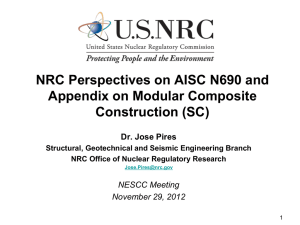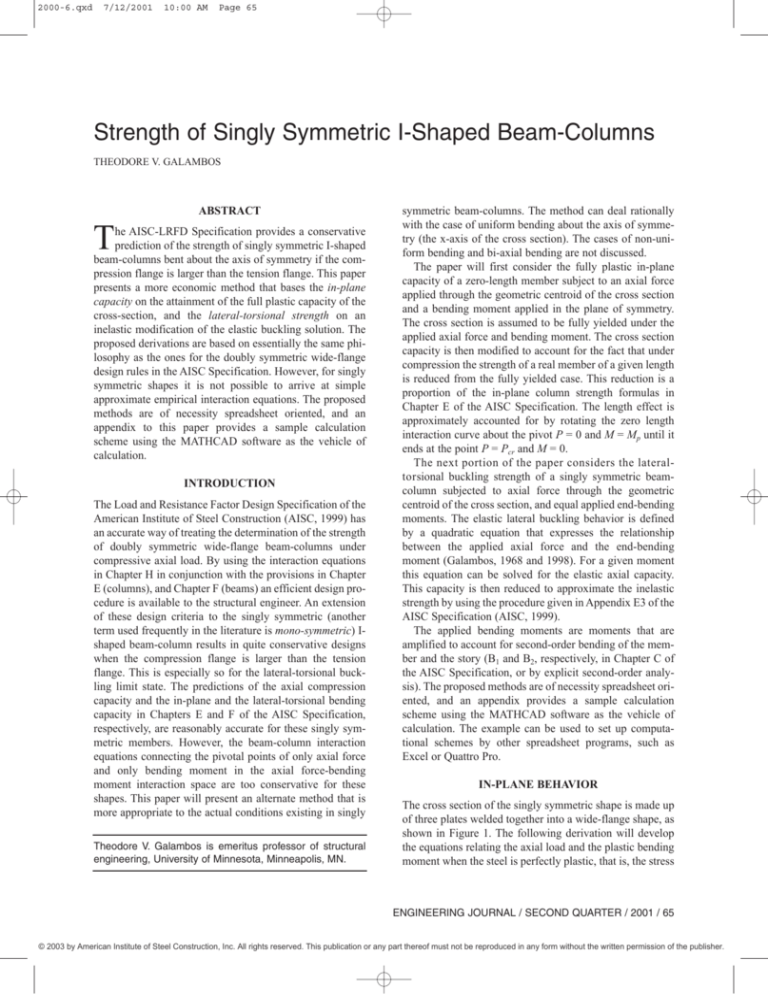
2000-6.qxd
7/12/2001
10:00 AM
Page 65
Strength of Singly Symmetric I-Shaped Beam-Columns
THEODORE V. GALAMBOS
ABSTRACT
T
he AISC-LRFD Specification provides a conservative
prediction of the strength of singly symmetric I-shaped
beam-columns bent about the axis of symmetry if the compression flange is larger than the tension flange. This paper
presents a more economic method that bases the in-plane
capacity on the attainment of the full plastic capacity of the
cross-section, and the lateral-torsional strength on an
inelastic modification of the elastic buckling solution. The
proposed derivations are based on essentially the same philosophy as the ones for the doubly symmetric wide-flange
design rules in the AISC Specification. However, for singly
symmetric shapes it is not possible to arrive at simple
approximate empirical interaction equations. The proposed
methods are of necessity spreadsheet oriented, and an
appendix to this paper provides a sample calculation
scheme using the MATHCAD software as the vehicle of
calculation.
INTRODUCTION
The Load and Resistance Factor Design Specification of the
American Institute of Steel Construction (AISC, 1999) has
an accurate way of treating the determination of the strength
of doubly symmetric wide-flange beam-columns under
compressive axial load. By using the interaction equations
in Chapter H in conjunction with the provisions in Chapter
E (columns), and Chapter F (beams) an efficient design procedure is available to the structural engineer. An extension
of these design criteria to the singly symmetric (another
term used frequently in the literature is mono-symmetric) Ishaped beam-column results in quite conservative designs
when the compression flange is larger than the tension
flange. This is especially so for the lateral-torsional buckling limit state. The predictions of the axial compression
capacity and the in-plane and the lateral-torsional bending
capacity in Chapters E and F of the AISC Specification,
respectively, are reasonably accurate for these singly symmetric members. However, the beam-column interaction
equations connecting the pivotal points of only axial force
and only bending moment in the axial force-bending
moment interaction space are too conservative for these
shapes. This paper will present an alternate method that is
more appropriate to the actual conditions existing in singly
Theodore V. Galambos is emeritus professor of structural
engineering, University of Minnesota, Minneapolis, MN.
symmetric beam-columns. The method can deal rationally
with the case of uniform bending about the axis of symmetry (the x-axis of the cross section). The cases of non-uniform bending and bi-axial bending are not discussed.
The paper will first consider the fully plastic in-plane
capacity of a zero-length member subject to an axial force
applied through the geometric centroid of the cross section
and a bending moment applied in the plane of symmetry.
The cross section is assumed to be fully yielded under the
applied axial force and bending moment. The cross section
capacity is then modified to account for the fact that under
compression the strength of a real member of a given length
is reduced from the fully yielded case. This reduction is a
proportion of the in-plane column strength formulas in
Chapter E of the AISC Specification. The length effect is
approximately accounted for by rotating the zero length
interaction curve about the pivot P = 0 and M = Mp until it
ends at the point P = Pcr and M = 0.
The next portion of the paper considers the lateraltorsional buckling strength of a singly symmetric beamcolumn subjected to axial force through the geometric
centroid of the cross section, and equal applied end-bending
moments. The elastic lateral buckling behavior is defined
by a quadratic equation that expresses the relationship
between the applied axial force and the end-bending
moment (Galambos, 1968 and 1998). For a given moment
this equation can be solved for the elastic axial capacity.
This capacity is then reduced to approximate the inelastic
strength by using the procedure given in Appendix E3 of the
AISC Specification (AISC, 1999).
The applied bending moments are moments that are
amplified to account for second-order bending of the member and the story (B1 and B2, respectively, in Chapter C of
the AISC Specification, or by explicit second-order analysis). The proposed methods are of necessity spreadsheet oriented, and an appendix provides a sample calculation
scheme using the MATHCAD software as the vehicle of
calculation. The example can be used to set up computational schemes by other spreadsheet programs, such as
Excel or Quattro Pro.
IN-PLANE BEHAVIOR
The cross section of the singly symmetric shape is made up
of three plates welded together into a wide-flange shape, as
shown in Figure 1. The following derivation will develop
the equations relating the axial load and the plastic bending
moment when the steel is perfectly plastic, that is, the stress
ENGINEERING JOURNAL / SECOND QUARTER / 2001 / 65
© 2003 by American Institute of Steel Construction, Inc. All rights reserved. This publication or any part thereof must not be reproduced in any form without the written permission of the publisher.
2000-6.qxd
7/12/2001
10:00 AM
Page 66
is equal to the yield stress Fy everywhere in the cross section. All three plates have the same yield stress.
The fully yielded cross section can have its plastic neutral axis in the top flange (Figure 2), in the web (Figure 3)
or in the bottom flange (Figure 4). When the neutral axis is
in the top flange, equilibrium of forces requires that:
(
M pc
(1a)
This equation can now be solved for yp, the distance of
the neutral axis from the top of the top flange:
A
[ p + 1]
2b f 1
(1b)
The equations of the location of the plastic neutral axis
and the plastic moment can be similarly derived for the
other cases. The equations are given below.
Plastic neutral axis in the web:
yp =
where
P
AFy
p=
2t f 1b f 1
A
−1 =
(
)
2 A f 1 + Aw
A
2A
A
-1
( p + 1)- f 1 + t f 1 for f 1 -1 ≤ p ≤
2t w
tw
A
A
(3)
2 Af 1
A
M pc
−1
The plastic moment can be obtained by taking moments
about the centroid of the cross section, where the axial force
P is assumed to act:
t f 1 yp
−
+
yp - t f 1 y −
2
2
t1
A f 1 y − 2 + tw
t f 1 + h + yp
= Fy
− y
t f 1 + h − yp
2
tf 2
+ Af 2 d −
− y
2
(
The limits of applicability of this equation are: yp = 0
when P = −AFy (or p = −1, i.e. the whole cross section is
yielded in tension); and yp = tf1 when:
p=
)
(2)
P = Fy − A + 2b f 1 y p
yp =
yp
t f 2 + yp
− b f 1 t f 1 − yp y −
+
b f 1 y p y −
2
2
= Fy
A t + h − y + A d − y − t f 2
f 2
w f 1 2
2
)
(
)
(4)
bf1
tf1
y
X
h d
Mpc
tw
Fy
yp
P
Y
centroidal axis
tf2
bf2
Fy
Fig.1. Cross section of the singly symmetric shape.
Fy
Mpc
P
yp
centroidal axis
Fy
Fig. 2. Plastic neutral axis in the top flange.
Fig. 3. Plastic neutral axis in the web.
Mpc
Fy
P
centroidal axis
yp
Fy
Fig. 4. Neutral axis in the bottom flange.
66 / ENGINEERING JOURNAL / SECOND QUARTER / 2001
© 2003 by American Institute of Steel Construction, Inc. All rights reserved. This publication or any part thereof must not be reproduced in any form without the written permission of the publisher.
2000-6.qxd
7/12/2001
10:00 AM
Page 67
Plastic neutral axis in the bottom flange:
A ( p − 1)
yp =
2b f 2
M pc
+ d for
(
2 A f 1 + Aw
A
For compressive yielding at the top of the top flange
)−1 ≤ p ≤ 1
tf1
h
Af 1 y −
− Aw t f 1 + 2 − y
2
yp + t f1 + h
= Fy
−
y p − t f1 − h
2
−b f 2
− d − y d + y p − y
p
2
(
)
(
)
(5)
P M (d − y )
−
= − Fy
A
Ix
(6)
Plastic Moment Capacity of Cross Section
tf1 = 0.75 in.; tf2 = 0.75 in.; tw = 0.5 in.; h = 20 in.;
bf1 = 15 in.; bf2 = 0.5 in.; Fy = 50 ksi
;
; y
AXIAL CAPACITY, P/Py
(8)
Similar expressions hold for the other three quadrants
shown in Figure 6. The AISC-type interaction equations for
the first quadrant of the zero-length member are:
P
M
P
+
= 1.0 for
≤ 0.2
Py
2 Py M p
(9)
P
8M
P
+
= 1.0 for
> 0.2
Py 9 M p
Py
(10)
In viewing Figure 5 it is evident that for a zero-length
member the AISC interaction equations are conservative in
the first and third quadrants, while in the second and fourth
quadrant they are slightly unconservative for this particular
cross section. Equations 9 and 10 are not strictly valid for
tee-shapes according to the AISC Specification Section
F1.2c. There the nominal moments are limited to 1.5My and
My, respectively, depending on whether the flange or the
stem are in compression (My is the yield moment). Because
the Equations 9 and 10 are not exactly in conformance they
are named “AISC-type formulas” herein.
The previous derivations, equations, and plots are applicable for the in-plane strength of the cross section, that is,
for a zero-length member. In the AISC Specification (AISC,
1999) the formulas for the cross section are generalized by
redefining the terms in the interaction equations: the
applied moment, M, is defined as the amplified moment
obtained from a second-order analysis of the frame. Alternately, M may be determined by the approximate procedure
PLASTIC MOMENT
0.5
(7)
For tensile yield at the bottom of the bottom flange
y
The interaction curves for the full plastic capacity of a
zero-length tee-shape is shown in Figure 5. The plastic limit
envelope is the heavy solid line. The axial force P is applied
through the geometric centroid of the cross section. The
directions of the applied forces are shown in Figure 6 for
the four quadrants of the interaction space. Also shown in
Figure 5 are the curves representing the relationship
between axial force and bending moment when the stress at
the extreme fiber is equal to the yield stress, and the interaction curve according to the specification of the American
Institute of Steel Construction (AISC, 1999). The axial
force axis shows the non-dimensional ratio P/Py, where
P y = AFy is the axial force when the whole cross section is
yielded in compression or tension. The bending moment
axis shows the non-dimensional ratio M/Mp, where the plastic moment Mp is defined by the formulas given in Appendix 1.
The formulas for the first yield interaction relationship
for the first quadrant (P is compressive and M causes compression on the top of the top fiber) are as follows:
1.0
P My
+
= Fy
A Ix
P
AISC
2
1
0.0
M
ELASTIC MOMENT
-0.5
3
-1.0
-1.5
-1.0
-0.5
0.0
0.5
1.0
4
1.5
MOMENT CAPACITY, M/Mp
Fig. 5. Interaction diagram for a zero-length tee-shape.
Fig. 6 Direction of axial force and bending moment on the cross section.
ENGINEERING JOURNAL / SECOND QUARTER / 2001 / 67
© 2003 by American Institute of Steel Construction, Inc. All rights reserved. This publication or any part thereof must not be reproduced in any form without the written permission of the publisher.
2000-6.qxd
7/12/2001
10:00 AM
Page 68
given in Chapter C, that is, M = B1Mnt +B2Mlt, where B1 and
B2 are amplification factors, and Mnt is the moment due to
applied forces causing no lateral translation, and Mlt is due
to forces causing lateral translation of the story under consideration. Mnt and Mlt are obtained in this case by performing a first-order analysis of the frame. The maximum value
of the axial force P is taken in the AISC procedure as the
yield strength of the cross section, Py = AFy, when the axial
force is in tension, and Pmax = Pcr, the in-plane critical load
computed by the column formulas in Section E2 (AISC,
1999). In effect, then, the zero-length interaction curve is
rotated so that its end at M = 0 is anchored to the point P =
Pcr. This is shown in Figure 7 for a singly symmetric member.
The geometric rotation of the interaction curve is accomplished by assuming that the compressive stress σ varies
from the yield stress Fy at P = 0 to the critical stress Fcr
when P = Pcr. For any value of P between P = 0 and P = Pcr
linear reduction is assumed, that is
(
σ = Fy − Fy − Fcr
)PP
(11)
cr
The equations for the plastic capacity (Equations 1
through 6) are consequently modified as follows:
Plastic neutral axis in the top flange:
Af 1
A p +1
p+1
yp =
for 0 ≤
≤
σ
b f 1 σ + 1
A
+1
F
Fy
y
yp
M pc = σ b f 1 y p y −
2
t f1 + yp
−b f 1 t f 1 − y p y −
2
+ Fy
t
+ A t + h − y + A d − y − f 2
w f1
f2
2
2
(
)
(13)
Plastic neutral axis in the web:
Af 1 p + 1 Aw + Af
A p + 1 Af 1
≤
yp =
−
+ t f 1 for
≤
tw σ + 1 tw
A σ + 1
A
F
F
y
y
(14)
1
tf1
σ
M pc = Af 1 y −
2
t f 1 yp
−
σ
ypt f 1 y −
2
2
+ tw
t f 1 + h + yp
− y Fy
+ t f 1 + h − y p
2
tf 2
+ Af 2 d −
− y f y
2
(
)
(
)
(15)
Plastic neutral axis in the bottom flange:
(12)
Geometrical Approximation of the Effect of Member Length,
In-Plane Behavior
A p + 1 A f 1 + Aw
−
+ tf 1 + h
yp =
b f 2 σ + 1
bf 2
F
y
for
A f 1 + Aw
A
+
1
p
≤1
≤
σ
+
1
F
y
(16)
tf1
h
M pc = Af 1 y −
σ − Aw t f 1 + − y σ
2
2
yp + tf1 + h
−
yp − t f 1 − h
2
−b f 2
d + yp
− d − y p 2 − y Fy
(
)
(
Fig. 7. Rotation of interaction curve.
)
y σ
(17)
The axial capacity Pcr in these equations is the critical
load in the plane of symmetry (the y-y axis in Figure 1, i.e.
buckling is about the x-x axis). The value of Pcr is deter-
68 / ENGINEERING JOURNAL / SECOND QUARTER / 2001
© 2003 by American Institute of Steel Construction, Inc. All rights reserved. This publication or any part thereof must not be reproduced in any form without the written permission of the publisher.
2000-6.qxd
7/12/2001
10:00 AM
Page 69
mined by the column formulas in Section E2 of the AISC
Specification:
L Fy
(18)
λx =
πrx E
Pcrx = AFcrx
Fcrx
dashed lines are for lateral-torsional buckling behavior (to
be discussed in the next section of this paper). The heavy
lines are depicting the curves of the fully plastic capacity
defined by Equations 12 through 17, and the thin lines represent the AISC-type interaction equations. The information
in Figure 9 is for rolled shapes: a 2L8×4×3/4 double angle,
and a WT18×67.5 tee section. From these typical curves it
can be observed that:
• The AISC-type interaction equations are an excellent
approximation for a doubly symmetric wide-flange
shape;
• In the second and fourth quadrants (see Figure 6 for
definition of the directions of the cross-sectional
forces), assuming that the top flange is larger than the
bottom flange, the AISC-type curves are close to the
fully plastic curves; and
• In the first and third quadrant the AISC–type approach
can be quite conservative, especially for tee-shapes.
(19)
0.658 λ x 2 F for λ ≤ 1.5
y
x
= 0.877 Fy
for
1.5
λ
>
x
2
λ x
(20)
Typical interaction diagrams are presented in Figures 8
and 9. The curves in Figure 8 are for built-up shapes: a doubly symmetric wide-flange shape, a cross section for which
the bottom flange is half as wide as the top flange, and a tee
shape. The solid lines represent in-plane strength, while the
tf1=0.75in; tf2=0.75in; tw=0.5in; h=20in;
bf1=15in; bf2=15in; L=15ft; Fy=50ksi;
tf1=0.75in; tf2=0.75in; tw=0.5in; h=20in;
bf1=15in; bf2=7.5in; L=15ft; Fy=50ksi;
1.0
AXIAL CAPACITY, P/Py
AXIAL CAPACITY, P/Py
1.0
0.5
0.0
-0.5
-1.0
-1.5 -1.0 -0.5 0.0
0.5
1.0
1.5
MOMENT CAPACITY, M/Mp
0.5
0.0
-0.5
-1.0
-1.5 -1.0 -0.5 0.0
0.5
1.0
1.5
MOMENT CAPACITY, M/Mp
tf1=0.75in; tf2=0.75in; tw=0.5in; h=20in;
bf1=15in; bf2=0.5in; L=15ft; Fy=50ksi;
AXIAL CAPACITY, P/Py
1.0
0.5
0.0
STRENGTH OF
MONO SYMMETRIC BEAM-COLUMNS
-0.5
heavy lines: proposed method
thin lines: AISC (1993) method
solid lines: in-plane capacity
dashed lines: lateral-torsional
buckling capacity
-1.0
-1.5 -1.0 -0.5 0.0
0.5
1.0
1.5
MOMENT CAPACITY, M/Mp
Fig. 8. Interaction curves for built-up singly symmetric shapes.
ENGINEERING JOURNAL / SECOND QUARTER / 2001 / 69
© 2003 by American Institute of Steel Construction, Inc. All rights reserved. This publication or any part thereof must not be reproduced in any form without the written permission of the publisher.
2000-6.qxd
7/12/2001
10:00 AM
Page 70
LATERAL-TORSIONAL BUCKLING
Pz =
The elastic lateral-torsional interaction relationship
between an axial force P and equal end bending moments
Mo about the x-axis, causing single curvature deflection
along the length of the beam-column, is given by the following quadratic equation (Galambos, 1968 and 1998):
(P
ey
)(
− Pe ro 2 Pz − ro 2 Pe + β x Mo
)=
(Mo + Pe yo )2
1 π 2 ECw
+ GJ
2
2
ro L
The cross-sectional properties ro, βx, Iy, Cw, and J are
defined in Appendix 1. The quadratic equation (Equation
21) is solved for Pe for a given Mo, and then an equivalent
slenderness parameter λce can be determined according to
Appendix E3 of the AISC Specification, as follows:
(21)
λ ce =
where
Pey =
π 2 EI y
(22)
L2
(23)
AFy
(24)
Pe
The critical lateral-torsional buckling load is then calculated using the AISC column formula:
Pltb = AFltb
(25)
tf1 = 0.75 in.; tf2 = 0.775 in.; tw = 0.5 in.; h = 6.5 in.;
bf1 = 8 in.; bf2 = 1.5 in.; Fy = 50 ksi; L= 10 ft.
2L8x4x3/4 LLV back-to-back
AXIAL CAPACITY, P/Py
1.0
0.5
0.0
-0.5
-1.0
-1.5
-1.0
-0.5
0.0
0.5
1.0
1.5
M OM ENT CAPACITY, M /M p
AXIAL CAPACITY, P/Py
t f1 =0.79in; t f2 =0.79in; t w =0.6in; h=16.2in;
b f1 =11.95in; b f2 =0.06in; L=20ft; F y=50ksi;
W T18x67.5
1.0
0.5
0.0
-0.5
-1.0
-1.5
heavy lines: proposed m ethod
thin lines: AISC (1993) m ethod
solid lines: in-plane capacity
dashed lines: lateral-torsional
capacity
-1.0
-0.5
0.0
0.5
1.0
1.5
M OM ENT CAPACITY, M /M p
STRENG TH O F M O NO-SYM M ETRIC BEAM -CO LUM NS
Fig.9. Interaction curves for rolled shapes.
70 / ENGINEERING JOURNAL / SECOND QUARTER / 2001
© 2003 by American Institute of Steel Construction, Inc. All rights reserved. This publication or any part thereof must not be reproduced in any form without the written permission of the publisher.
2000-6.qxd
7/12/2001
10:00 AM
Page 71
0.658 λ ce 2 F for λ ≤ 1.5
y
ce
Fltb = 0.877 Fy
for λ ce > 1.5
2
λ ce
SUMMARY AND CONCLUSIONS WITH EXAMPLE
(26)
The resulting curves for the various cross sections are
shown in Figures 8 and 9 by the heavy dashed lines. The
AISC-type interaction curves are shown as the thin dashed
lines. The in-plane strength is shown as solid lines, and the
lateral-torsional strength is depicted as dashed lines. For a
doubly symmetric wide-flange shape (curves in the top left
corner of Figure 8) the in-plane strength computed by the
method of this paper and the AISC-type interaction equations give an essentially identical result. For lateraltorsional buckling it is seen that this mode of failure
governs only over a region of small moment and high axial
force when the method of this paper is used, but that the
AISC-type interaction equation method requires a reduction
of the moment over all moment values. The differences
between the AISC-type interaction equation predictions and
the proposed method become more pronounced for sections
that have a different flange top and bottom, or that are tee
shapes. The AISC-type approach compares closely with the
proposed method for in-plane strength prediction in the second and fourth quadrants, but it is conservative in the first
and third quadrants. The lateral-torsional buckling strength
is closely predicted by the AISC-type equations in the second quadrant (compression in the smaller flange), but they
are quite conservative in the first quadrant (compression in
the larger flange). In this case lateral-torsional buckling is
not critical over significant regions of the domain of forces.
The double angle case (top diagram in Figure 9) is a special
case that shows a smaller effect of lateral-torsional buckling. The curves in Figures 8 and 9 illustrate the phenomena
that are at work for these singly symmetric sections. The
AISC-type method is a reasonably good approach when the
compressed flange is the smaller one. When the compressed
flange is the larger one, both the in-plane and the lateral-torsional buckling predictions of the AISC-type method can be
significantly conservative.
The presentations in this paper are not amenable to easy
manual calculation. For this reason spread sheets can be
very advantageous. The enclosed Appendices 2 and 3 give
programs for the MATHCAD 8 PROFESSIONAL software. Appendix 2 presents the calculation scheme for the
proposed in-plane and lateral-torsional buckling methods.
Appendix 3 gives the AISC Specification method for the
lateral-torsional buckling checking. This program is presented to demonstrate that the proposed method and the
AISC method require about the same amount of computational effort.
This paper has demonstrated that the interaction equations
of the AISC give quite conservative designs for singly symmetric wide-flange shapes when the larger of the flanges is
under compression. This conclusion can be seen in the
curves in Figures 8 and 9 for several example beamcolumns. In order to obtain a further feeling for the differences between the proposed and the AISC methods, a
numerical example will be discussed below.
Problem statement: Compare the required strengths determined by the method of this paper and the AISC Specification for a simply supported tee-shaped beam-column
subjected to a factored compressive axial load Pu = 400 kips
through the centroid of the tee section, and to equal end
moments Mu = 2,000 kip-in. These moments cause single
curvature bending about the x-axis of the member such that
the flange of the tee is in compression. The length of the
member is 20 ft. The section is built up using a
WT18×67.5 tee section and a bottom flange plate, and the
yield stress of the steel is Fy = 50 ksi. The details of the
strength check are given in the MATHCAD8 Professional
programs reproduced in Appendices 2 and 3. Appendix 2
pertains to the method proposed in this paper, and Appendix 3 presents the steps of the AISC Specification.
In-plane strength: (member is laterally braced)
Proposed method: (Appendix 2)
For Pu = 400 kips the factored flexural strength is φbMpc =
3,580 kip-in.
The margin is: φbMpc − Mu = 1,580 kip-in.
Ratio: Mu / φbMpc = 2,000/3,580 = 0.56
The beam-column can actually support 3,580 kip-in. of
moment in the presence of a 400 kip axial force.
AISC-type Method:
From Appendix 2, Pnx = 0.878
Py
From Appendix 2, Py = AFy = 982 kips
φcPnx = 0.85 × 0.878 × 989 = 733 kips
Pu
= 400/733 = 0.54 > 0.2
φ c Pnx
From Appendix 2 (or from Appendix 3), the plastic moment
Mp = 4,505 kip-in.
φbMn = 0.9Mp = 0.9 × 4,505 = 4,055 kip-in.
AISC Interaction Equation:
Pu
Mu
8
8 × 2,000
+ ×
= 0.54 +
= 0.98
φc Pnx 9 φb Mn
9 × 4,055
ENGINEERING JOURNAL / SECOND QUARTER / 2001 / 71
© 2003 by American Institute of Steel Construction, Inc. All rights reserved. This publication or any part thereof must not be reproduced in any form without the written permission of the publisher.
2000-6.qxd
7/12/2001
10:00 AM
Page 72
The member could actually support a moment of 2,098 kip-in.
Lateral-torsional buckling strength
Ratio: proposed method/AISC interaction equation
method = 3,580/2,098 = 1.71
Proposed method:
The AISC LRFD specification also provides an alternate
approach in Section H3: the maximum elastic stress in the
cross section, fmax ≤ φbFy = 0.9 × 50 = 45 ksi.
The compressive top flange elastic stress is
P M y
f tf = u + u = 45 ksi
A
Ix
The maximum required moment can then be determined
from the relationship
P I
M u = 45 - u x
A y
With Pu = 400 kips, A = 19.634 in.2, y = 5.011 in., and Ix =
633.075 in.4, the value of Mu is computed to be 3,111 kip-in.
P M ( d − y)
fbf = u − u
A
Ix
3,111 × (17.78 − 5.011 )
400
−
19.634
633.075
= −42.38 ksi ≤ −45 ksi
=
The stress in the bottom flange is
The required tensile stress in the bottom flange is less than
45 ksi, and so the maximum permitted bending moment is
3,111 kip-in. This is higher than the 2,098 kip-in. obtained
by using the interaction equation method (3,111/2,098 =
1.48).
From Appendix 2 and for Mu = 2,000 kip-in, we get φcPn =
399 kips ≈ 400 kips. The member is just OK.
AISC method:
From Appendix 3 with the top flange in compression, the
AISC interaction sum equals 1.94, indicating that the member is under strength. The beam-column can actually only
support φcPn = 144 kips.
Ratio: proposed method / AISC method = 399/144 = 2.77
Another type of comparison of the proposed method with
the AISC Procedure can be made by considering the computational effort required in determining the lateraltorsional buckling strengths in Appendices 2 and 3. The
AISC method requires a solution of a complicated non-linear equation to obtain the value of Lr (see Appendix 3). The
required computational effort is essentially the same for
both approaches. For about the same amount of effort, then,
one can use a theory that is less conservative than that of the
AISC Specification.
REFERENCES
AISC (1999), Load and Resistance Factor Design Specification for Structural Steel Buildings, American Institute
of Steel Construction, Chicago, IL
Galambos, T. V. (1968), Structural Members and Frames,
Prentice-Hall, Englewood Springs, NJ
Galambos, T. V. (1998), Guide to Stability Design Criteria
for Metal Structures, Wiley Interscience, New York, NY
Ratio: Proposed method / AISC elastic limit method =
3,580/3,111 = 1.15.
72 / ENGINEERING JOURNAL / SECOND QUARTER / 2001
© 2003 by American Institute of Steel Construction, Inc. All rights reserved. This publication or any part thereof must not be reproduced in any form without the written permission of the publisher.
2000-6.qxd
7/12/2001
10:00 AM
Page 73
APPENDIX 1.
Cross-sectional Properties (rev. 6/5/00)
ENGINEERING JOURNAL / SECOND QUARTER / 2001 / 73
© 2003 by American Institute of Steel Construction, Inc. All rights reserved. This publication or any part thereof must not be reproduced in any form without the written permission of the publisher.
2000-6.qxd
7/12/2001
10:00 AM
Page 74
APPENDIX 2.
In-plane and LTB Strength of Singly-symmetric I-shaped Beam-columns
74 / ENGINEERING JOURNAL / SECOND QUARTER / 2001
© 2003 by American Institute of Steel Construction, Inc. All rights reserved. This publication or any part thereof must not be reproduced in any form without the written permission of the publisher.
2000-6.qxd
7/12/2001
10:00 AM
Page 75
ENGINEERING JOURNAL / SECOND QUARTER / 2001 / 75
© 2003 by American Institute of Steel Construction, Inc. All rights reserved. This publication or any part thereof must not be reproduced in any form without the written permission of the publisher.
2000-6.qxd
7/12/2001
10:00 AM
Page 76
APPENDIX 3.
AISC Interaction Calculations for LTB
76 / ENGINEERING JOURNAL / SECOND QUARTER / 2001
© 2003 by American Institute of Steel Construction, Inc. All rights reserved. This publication or any part thereof must not be reproduced in any form without the written permission of the publisher.
2000-6.qxd
7/12/2001
10:01 AM
Page 77
ENGINEERING JOURNAL / SECOND QUARTER / 2001 / 77
© 2003 by American Institute of Steel Construction, Inc. All rights reserved. This publication or any part thereof must not be reproduced in any form without the written permission of the publisher.


